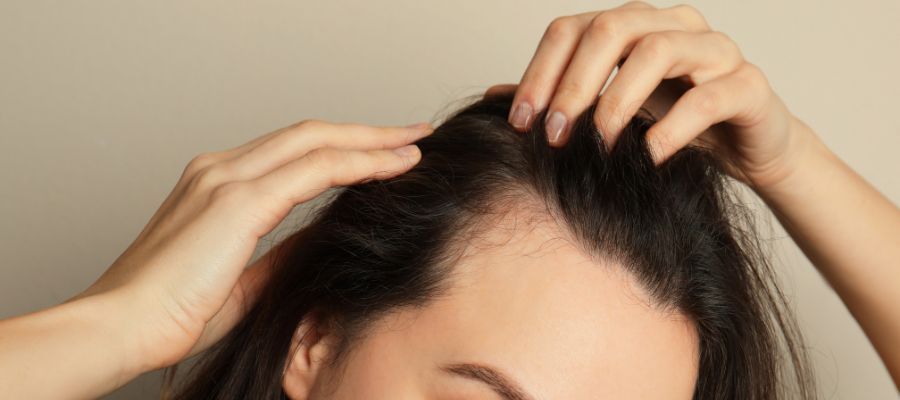Hair Loss Treatments
We will serve you with an initial evaluation, then develop a long-term plan that optimizes the scalp environment, boosts hair strand strength and resilience and stimulates the follicular growth cycle. The plan also includes diet evaluation and supplements.
Get Ready for long Term Healthy Hair!
Hair loss is a complex problem with many contributing factors and a host of possible solutions. We will help you sort out the details and get you results.
Our treatment system revolves around the details in your medical history, laboratory work-up and a meticulous videoscopic analysis of your hair and scalp. This comprehensive assessment aids in pinpointing the underlying cause(s) of the issue. Next, we explore all evidence-based treatments available and craft a personalized plan aimed at achieving your desired results. Finally, as you move through the treatment process, we actively monitor your progress, adjusting accordingly, to determine the next steps needed for long-term success.
HairLoss Solutions
Hair loss can be a distressing experience, impacting both physical appearance and emotional well-being. Our approach to addressing hair loss goes beyond surface solutions. We conduct a thorough examination, analyzing your medical history, conducting laboratory work-ups, and employing meticulous videoscopic analysis of your hair and scalp. This comprehensive assessment allows us to identify the root cause(s) of the issue. Based on these findings, we tailor evidence-based treatments into a personalized plan aimed at achieving your desired results. Throughout your treatment journey, we closely monitor your progress, making necessary adjustments to ensure long-term success.
Male and Female Patterned Baldness
Medical Terminology: Androgenic Alopecia
Male and female pattern baldness (MPB/FPB) are the most common types of hair loss worldwide. They happen due to a combination of genetics and natural hormone levels, which causes hair follicles to shrink over time. As a result, hair becomes thinner, weaker, and eventually stops growing.
For men, this usually means a receding hairline and thinning at the crown, while women often notice overall thinning, especially at the top of the head. While MPB and FPB are natural, hair loss doesn’t have to be inevitable! With early intervention and the right treatments, it’s possible to slow things down—or even regrow hair with professional guidance.
Hair Shedding
Medical Terminology: Alopecia Areata, Telogen/Anagen effluvium, Post-partum hair loss
Hair shedding happens when more hair follicles than usual shift from the growth phase to the resting or shedding phase. Shedding a common concern with many possible triggers, including stress, hormonal changes, nutritional deficiencies, and even certain health conditions.
Shedding patterns can vary—from small round patches to overall thinning and, in some cases, even affecting hair across the entire body.
The keys to managing hair shedding are early intervention, identifying the root cause, and taking a holistic approach to care.
Hair Loss From Scarring
Medical Terminology: Scarring Alopecia
Scarring alopecia refers to a group of hair loss conditions where the hair follicles are damaged, usually due to the body’s own immune system mistakenly attacking them.
Scarring hair loss patterns can vary—damage may appear on the crown, along the frontal hairline, or in patches, depending on the underlying cause.
Because these conditions are progressive and can lead to permanent hair loss if untreated, early recognition and treatment are key to preserving hair and preventing further damage.
Tension/Traction-Related Hair Loss
Medical Terminology: Traction Alopecia
Traction alopecia is a type of hair loss caused by repeated pulling or tension on the hair. This often happens from wearing tight hairstyles like braids, ponytails, weaves, or extensions, as well as using snug headbands, wraps, or hats that create constant friction.
Over time, this strain weakens the hair follicles, leading to inflammation, thinning, and even bald patches—especially around the hairline, which is the most delicate and vulnerable area. If the pulling continues for too long, the hair loss can become permanent.
Traction alopecia is often reversible if caught early!
Hair Loss Due to Chemo Therapy
Medical Terminology: Anagen effluvium
Chemotherapy can be a life-saving treatment, but one of its most well-known side effects is hair loss. This happens because chemo targets rapidly dividing cells, which includes not just cancer cells but also the fast-growing cells in hair follicles. As a result, hair may start thinning or falling out in clumps a few weeks after treatment begins.
The extent of hair loss varies—some people experience complete baldness, while others notice only mild shedding. In most cases, hair begins to regrow a few months after treatment ends, sometimes with a temporary change in texture or color.
While hair loss from chemo can be an emotional challenge there are many options for treatment that can begin even before your chemotherapy journey begins.
Postpartum Hair Loss
Medical terminology: Post-partum alopecia
Hair loss during and after pregnancy is common and usually temporary. During pregnancy, hormonal changes often cause hair to grow thicker and fuller, as more strands stay in the growth phase. However, after giving birth, hormone levels drop, triggering a condition called postpartum hair shedding.
Post-partum hair hair loss can lead to noticeable thinning as more hairs than usual fall out at once. This shedding typically peaks a few months after delivery and gradually slows down, with hair returning to its normal growth cycle within a year.
Meanwhile, an holistic hair restoration plan can safely help support healthy regrowth.








